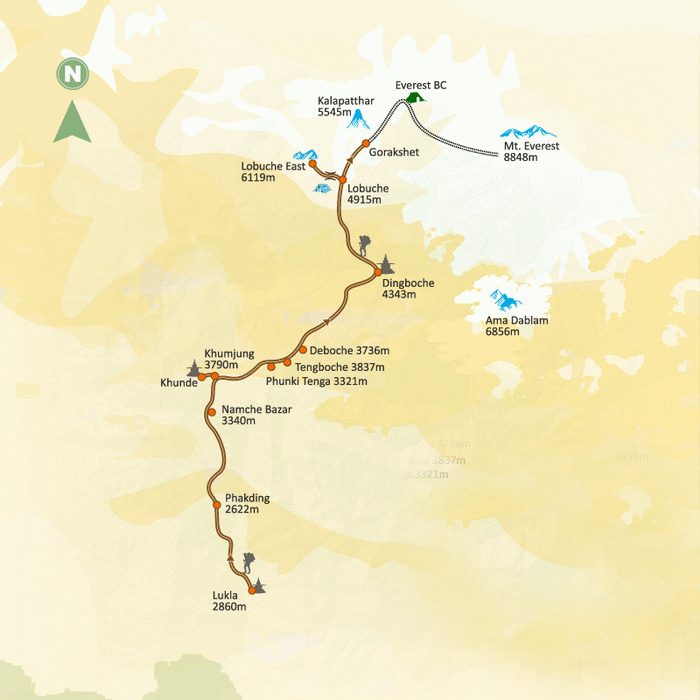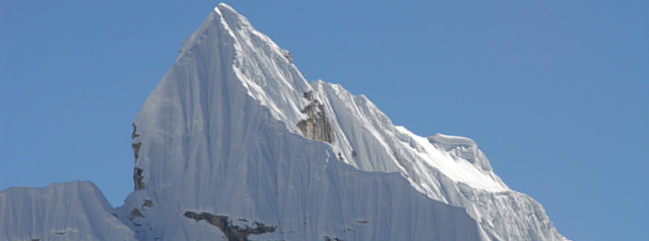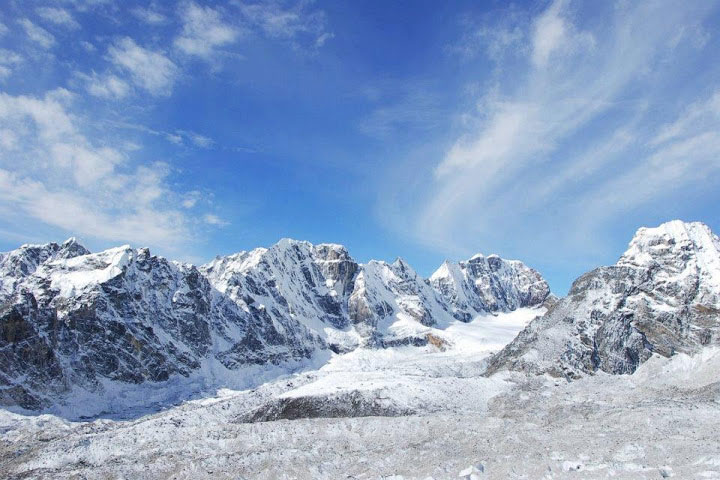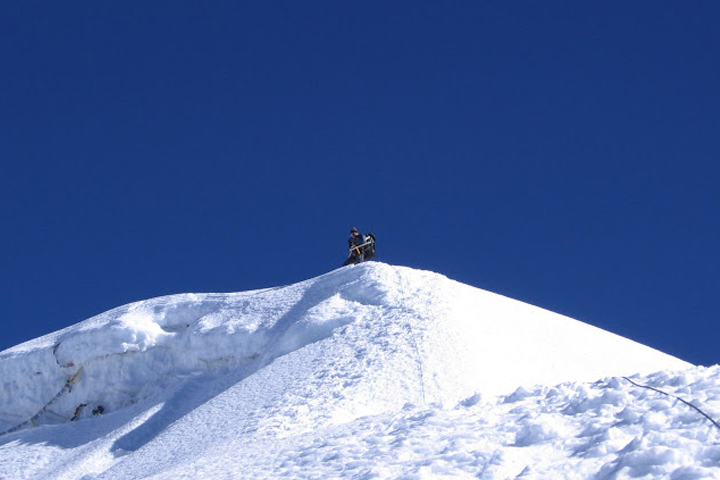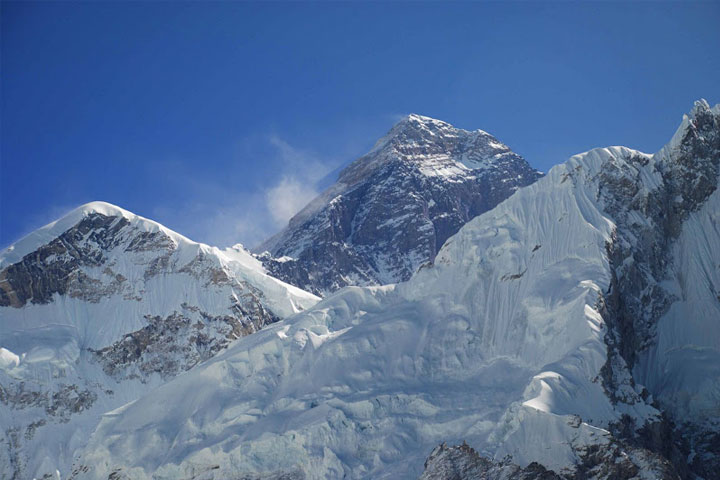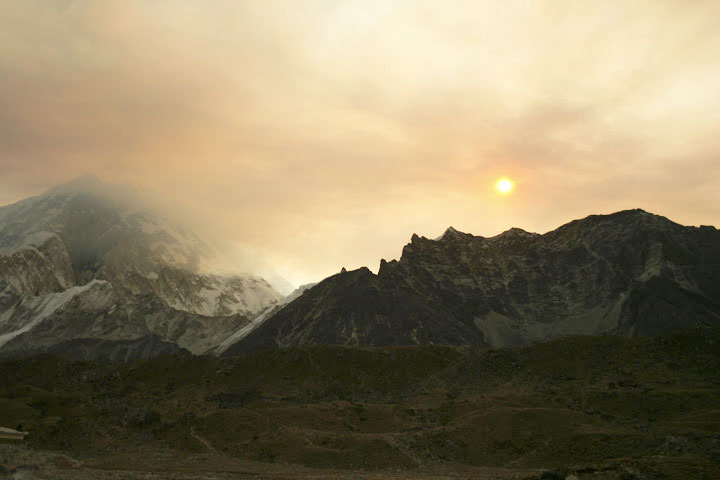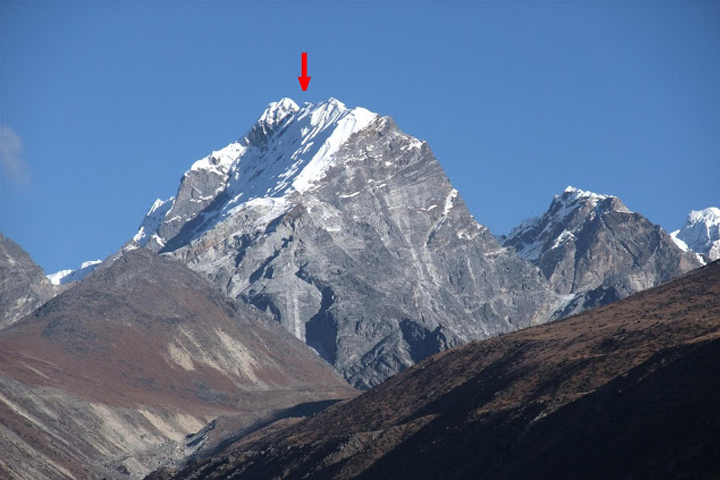Lobuche peak 6119m is one of the popular trekking peaks in Everest region. Lobuche peak is an attractive summit and offers various routes for climbing. Lobuche peak climbing is challenging trekking peaks in Everest region .The normal route for climbing is through South Ridge. Lobuche east peak consists of several small summits and the true summit requires climbing steep snow and ice slopes to the top from the summit ridge.
We follow Everest base camp Trekking, route up to Pheriche and then trek to Dughla. Lobuche peak base camp will be set up at 4,950m. near a lake in a rocky hollow at the base of the glaciated South-West Face. The views of Amadablam, Cholaste, Thamserku, Kantega peak and Tawache peak are superb from here. We climb steep stone terraces and snow slopes just below the main glaciers on the South-West Face of Lobuche East. We climb steep snow and ice slopes using fix ropes and get access to the ridge overlooking Lobuche and the Khumbu Glacier where we fix the high camp.
We follow the sharp snow ridge to the summit ridge. Then we follow the route to north-west towards the main summit passing several small snow bumps and reach a notch. Then we further climb steep and quite difficult snow slopes to the true summit. The peak can be climbed from East Face by climbing a dark pyramid of slabby rock and join the South Ridge to get to the summit.
Day 01- Arrival in Kathmandu airport (1345meters).
There you will be met by our Airport Representative and transferred to hotel by private tourist vehicle. Overnight at hotel.
Day 02- Pre-trip Meeting and Sightseeing around Kathmandu valley.
In the morning after breakfast at 9 AM, we host a Pre-Trip meeting at your hotel in Kathmandu and introduced your trek Leader/Guide mean time and it will provide an opportunity for individuals to ask questions about the your trek and to introduce you to other participants. This includes a final briefing and preparations for the trip.
PLEASE ADVISE US IF YOU WILL BE ARRIVING LATE AND ARE THEREFORE UNABLE TO ATTEND THE PRE-TRIP MEETING.
In THE PRE-TRIP MEETING All passengers MUST bring:
1. Passport.
2. Four copies of Passport size photos each.
3. Travel Insurance Policy.
4. A writing pen
5. Notepad.
After the Pre-Trip meeting and breakfast your sightseeing trip will start at 9.45 AM in the morning. We provide a private vehicle and professional tour guide. We visit Bodhnath Stupa, one of the biggest Buddhist shrines in the world, where we observe Buddhist monks in prayer in the monasteries surrounding the stupa. After Bodhnath Stupa we visit Pashupatinath, the most famous Hindu temple in the country, located on the banks of the holy Bagmati River. Here we see Hindu holy men (sadhus) meditating, pilgrims bathing and occasionally funeral pyres burning on the ghats. We also visit Bhaktapur Durbar Square, which is a collection of pagoda and shikhara – style temples grouped around a fifty-five-window palace of brick and wood. The attraction of the Bhaktapur Durbar Square is The Lion gate, The Golden gate, The Palace of fifty five windows, Art Galleries, The Statue of King Bhupatindra Malla.
The rest of our time in Kathmandu is free for further exploration and some last-minute shopping in Thamel area near by your hotel. Later, we are supplied with our Trek Pack and departure information for tomorrow. Overnight at hotel.
Day 03- Fly to Lukla (2804 meters) trek to Phakding (2610 meters) 3 hours.
An early morning start takes us to Tribhuwan international Airport in Kathmandu for the 35 minute scenic flight to Tenzing and Hillary Airport at Lukla at 2804meters. On arrival at the airport guide will brief you and introduce our porters before we begin our trek towards Phakding at 2610meters.
After landing we have time to explore the village while our Sherpa crew sort and load our trekking equipment. Then we begin our trek by descending towards the Dudh Kosi River where we join the main trail to Namche Bazaar, located just above Chaunrikharka (2713m). The walking is easy and after passing through the small village of Ghat (2550m) it is a short walk to Phakding. Overnight at guesthouse.
Day 04- Trek to Namche Bazaar (3441 meters) 5.30 hours.
We continue trekking along the banks of the Dudh Kosi, crossing this majestic river many times on exciting suspension bridges laden with prayer flags. After entering Sagamartha National Park, the trail climbs steeply with breathtaking views. Namche Bazaar known as the Gateway to Everest which is home to many quality restaurants, hotels, lodges, shops, Money exchange, internet cafe and a bakery. Namche is one of the biggest villages along the whole Everest trail. Overnight at Guesthouse.
Day 05- Namche Bazaar Acclimatization day.
We will spend a day here in order to acclimatize and adjust to the thinning of the air. As well as a short trek there is a museum celebrating the traditional customs of the Sherpa people to visit. Today we hike up the Syangboche Airport, and around Everest View Hotel. From this point, we can see rewarding views of the Himalayas with a stunning sunrise or sunset over the panorama of the Khumbu peaks. Overnight at guesthouse.
Day 06- Trek to Tengboche Monastery (3860 meters) 5 hours.
We trek to an altitude of 3860meters today. On reaching Tengboche your guide will tell you about the local monastery situated here. The group will be taken to observe a prayer ceremony either in the evening or morning depending on how the days trekking went. Overnight at guesthouse.
Day 07- Trek to Dingboche (4350 meters) 5.30 hours.
From Thyangboche the trail drops to Debuche, crosses another exciting suspension bridge on the Imja Khola, and climbs to Pangboche amongst thousands of mani stones. Our uphill trek continues, taking us to the quaint traditional Sherpa village of Dingboche with its exquisite views of Lhotse, Island Peak, and Ama Dablam. We take our time so we avoid getting affected by the altitude. Overnight at Guesthouse.
Day 08- Trek to Chhukung (4710 meters) and trek back to Dingboche. 4.30 hours.
Today you can enjoy another day for acclimatization. We will have trip to Chhukung valley via the Imja Khola valley to get a marvellous view of the surrounding mountains, especially Lhotse’s massive south wall, then return to Dingboche in the evening. Overnight at Guesthouse.
Day 09- Trek to Lobuche (4910 meters) 5 hours.
Today, the trail continues along the lateral moraine of the Khumbu Glacier and passes by stone memorials for climbers who have perished on nearby summits.We continue to climb as we are heading to the altitude of 4910 meters at Lobuche which is really just a few huts at the foot of giant Lobuche peak. Some breathing problems may arise today due to the altitude. Overnight at Guesthouse.
Day 10- Trek to Everest Base Camp (5365 meters) then trek back to Gorak Shep (5180 meters). 7 hours.
After an early morning start leaving Loubuche, we head up to Everest Base camp (5365meters) you will have unobstructed views of many mountain giants like Nuptse, Pumori, Chagatse and Lhotse looming directly ahead and on all sides. Then we make our return to Ghorakshep at elevation of 5180 meters at noon for our overnight stay. Overnight at Guesthouse.
Day 11- Trek to Kalapattar (5555 meters) then trek down to Lobuche (4930 meters) 6 hours.
After reaching Base camp of Everest our aim today is to trek Kalapattar (5555meters). We start early to reach the viewpoint that offers some of the best views of Mount Everest as well as other panoramas of the surrounding mountains. We then descend to Lobuche at elevation of 4930 meters. Overnight at guesthouse,.
Day 12- Trek to Lobuche Peak Base Camp (4950 meters). 5 hours
After walking over flat about half way you begin to follow steep ascent path to reach Lobuche Base Camp. The path is quite rocky and it moves along the bank of Lobuche Glacier. While trekking, you can enjoy the spectacular views of Cholatse, Tawache, Ama Dablam, Pokalde, Thamserku, Kantega and many more. From today the accommodation will be tented camp for next two days and you will be having camp food cooked by our professional cook. Overnight at tented camp.
Day 13- Summit to Lobuche East Peak (6119 meters) then back to Base Camp.
Today is our main adventure day, we start early in the morning to climb Lobuche peak but it all depends on the weather condition. it takes about ten hours. At the summit you will catch panoramic views of Everest, Lhotse, Nuptse, Ama Dablam, Tawache, Cholatse, Pumori, Changri and more. After a safe trip to the top we safely make our way down then same day back to Base Camp. Overnight at tented camp.
Day 14- Spare day in case of bad weather.
Day 15- Trek to Pangboche (4000 meters) 6 hours.
After summating the Lobuche peak, we then descend to Pangboche at elevation of 4000 meters. Overnight at guesthouse.
Day 16- Trek to Namche (3441 meters) 6 hours.
Leaving the mountains behind us our descent takes us through Tengboche Monastery at elevation of 3860 meters before continuing back to the town of Namche Bazaar at 3441meters. We arrive back into Namche Bazaar in the afternoon. Overnight at guesthouse.
Day 17- Trek to Lukla (3404 meters) 6 hours.
Finally we return to Lukla where the trek began, which seems a lifetime ago. Enjoying time to reflect on the trek as a group and the personal achievement of all those who took part. Overnight at guesthouse.
Day 18- Morning flight to Kathmandu from Lukla
Enjoying your last glimpse of the mountains you have recently visited for one last time on the 35 minute Scenic flight back to Kathmandu. On arrival in Kathmandu we are met and transferred back to our starting hotel. Overnight at hotel.
Day 19- Leisure day in Kathmandu.
It’s also spare day incase of bad weather in Lukla, If you are interested in continuing onto Chitwan Jungle Safari, River Rafting Adventure, Kathmandu Shopping Tour or Scenic Everest Flight.
Day 20- Transfer for your final flight departure.
The trip ends, our Airport Representative will drop you to the Kathmandu international airport for your flight departure from Nepal.
NOTE : The above information is a guide and standard template of what we provide. The trek can be customized at your request to accommodate your specific requirements.
NOTE : On adventure trips of this type, weather, local politics, transport or a multitude of other factors beyond our control can result in a change of itinerary. It is, however, very unlikely that the itinerary would be substantially altered; if alterations are necessary the leader will decide what is the best alternative, taking into consideration the best interests of the whole group. Where a change does occur, we do everything we can to minimize its effect, but we cannot be responsible for the results of changes or delays.
Q. How fit do I have to be and is trip for me?
A. Climbing Peak provides the most adventurous experience with spectacular scenery through remote glaciated valleys and passes. This trip requires you to have an above normal level of fitness which will assist with climbing Peak. Any person suffering from a pre-existing medical condition or diseases must seek medical advice before considering this trek. Whilst on the trek, it is common to experience some discomfort before being fully acclimatized.
To prepare for a strenuous trek you should begin training at least two to three months before your departure. As a guideline, an hour of aerobic exercise three to four times per week would be considered a minimum requirement. The best preparation is bushwalking involving relatively steep ascents and descents. If you can manage a couple of valley floor to ridgeline ascents per comfortable and able to enjoy the trek to the fullest. They are physically strong, sharp-witted and have an incredibly positive attitude towards a life that we would consider extremely tough. There is something about a trek in the Himalaya that draws you back time and time again. For keen walkers it is a paradise and even avowed non-walkers find that one foot just seems to follow the other, drawn by the appeal of what lies beyond.
Q. Will somebody come to pick me up at the Airport upon my arrival?
A. Yes, our Airport Representative will be there to greet you outside of Terminal Hall, he/she will be displaying an Kiwi Adventures Treks & Expedition sign with your name on it. Upon arrival, you will be transferred to your hotel.
Q. What sort of accommodation can I expect in Kathmandu and in trekking?
A. We use standard rooms from three/four star hotels in Kathmandu with breakfast included. Along the trekking routes teahouses/Lodges generally provide basic clean facilities with a mattress and a quilt or blanket. We can also offer you sleeping bags if needed (which need to return after the trip) but it is good idea to always have your own sleeping equipment. We usually provide single and double rooms as well as the occasional dormitory. The dining room is downstairs around a fire. All food will be cooked to order in the little kitchen. You should not enter the kitchen unless asked to do so.
Toilet Facilities – On trek, common toilet facilities are available at Tea Houses.
Q. What sort of food can I expect in trekking?
A. Most teahouses (lodges) cook a delicious range of mostly vegetarian fare. Pasta, tuna bakes, noodles, potatoes, eggs, dhal bhat, bread, soups, fresh vegetables (variety depends on the season) and even some desserts like apple pies, pancakes, and some interesting attempts at custard. You will find a lot of garlic on the menu because it assists with acclimatization – eat some every day. In many larger villages you may find some meat on the menu. You can always get hot chocolate, tea, and hot lemon drinks, as well as soft drinks, and treats like chocolate and crisps.
During the Camping, our export camping cook can prepare specially requested food if you advise. In any case, you will have similar fare to teahouses.
Each day dinner and breakfast are used to take in the same lodge you spend the night. Lunch will be taken on the way to destination.
Q. What sort of transportation you use?
A. Kiwi Adventures Treks & Expedition is all about providing you with local insights as well as adventure, with that in mind, where we think you will get more out of your holiday by using different means of transport that is what we do. Using a variety of private transport is an integral part of our Himalaya tours and enhances the experience!
We use private tourist vehicles for sightseeing, city tours and pickups. Depending on the group size we use cars, minibus, van, land cruiser. These small light vehicles are more manoeuvrable and flexible enabling us to take you through the Narrow roads of Nepal. All the vehicles are usually air-conditioned unless we are travelling in cooler areas.
Q. What is the best season for this trip?
A. The best time for this trip is October to November and March to May.
Q. What is the weather & temperature like in trekking?
A. Weather in the mountains is notoriously difficult to predict. At night it is generally cooler with the days being warmer, and in winter (January and February) it will be bit colder but the days can be quite beautiful and warm if the sun is out. There will be snow any time of year. It is also important to make sure that you can stay warm and dry in just about any conditions. Expect the unexpected! The temperature could be as high as 20 deg C to -15 deg C low.
Q. Can I charge my digital camera or other batteries on my trip?
A. These facilities will be available in most of the places in your hotel reception by paying some service charges. Remember to bring your adapters!
Q. Is there any communication while we are on trekking?
A. There are telephones in some villages along the trekking routes from which you can make international calls.
Q. Can I use credit cards in the places visit in trekking?
A. In most cities yes, to some extent, however once you leave those cities behind you will only need cash.
Q. How much additional money do I need per day?
A. In Kathmandu, you can allocate US$ 10 – 25 for a lunch / dinner. It’s all depends on your spending habits. US$10 to 20 US$ a day will be enough to buy bottles of water, chocolates and few drinks in trekking.
Q. Do I need to tip my guide and porters? How much would that be?
A. This is a difficult thing to judge. We have seen everything from 20USD to 1000 USD per person for guides and porters. Tipping is not required, but a small way to show your guides and local porters thanks for their help. The level of the tip should reflect the level of personal involvement with your guide.
Q. Is the water OK to drink? Do I need to bring purifying tablets/filter?
A. In most places bottled water is readily available. But it is important for you to drink normal water, so bring purifying tablets with you. During camping we provide boiled water to drink.
Q. Are the Kiwi Adventures Treks & Expedition staff insured?
A. Our company insures all our trekking staff, including guide, cook, Sherpa and porters.
Q. What essential documents do I need to bring with me on tour?
A. *Valid Passport – must be valid for up to 6 months after you return from your tour, keep a separate photocopy.
*Travel insurance, keep a separate photocopy
*Cash and Traveller’s Cheques, keep numbers and proof of purchase separate
*Flight tickets
*Emergency contact numbers for T/C’s, banks, insurance, family contacts.
Q. Can I add extra days to my trekking trip?
A. A trekking holiday should never be about making it to the final point quickly. Along your trek we can add days at your request with additional costs to cover guides, porters, accommodation and food.
Q. Do you use yaks/porters on the trek or do we carry all of our own gear?
A. Whilst on the trek, our porter will take care of your luggage. All you need to carry is your small day bag for your personal belongings like camera, water bottle, sun cream etc only.
Q. What opportunities will I have for shower along the trek?
A. In major places, we arrange guesthouse with hot shower. And in rest of the places, hotel water in bucket will be provided for shower; it would cost you extra about USD 5-8 per shower.
Cost Includes
• Airport / Hotel / Airport pick up & drop by private car / van / bus.
• Standard twin sharing accommodation in three/four star hotel in Kathmandu breakfast included.
• Guided city tour in Kathmandu by private car / van / bus.
• All your standard Meals as per itinerary during the trek and Climb.
• Hot drinks during camping (from Island epak base camp and above).
• Tea Houses / Lodges, Guesthouses and Tented accommodation during the trek.
• A government licensed English speaking Guide during the trek and climb.
• The required number of staff and Porters to carry your luggage during the trek.
• Food, accommodation, salary, insurance, equipment, medicine for all staff.
• Everest National Park permits.
• Lobuche Peak Permit fees.
• Garbage Deposit Fee.
• General Climbing equipment such as Rope, Ice Screw, Snow Bar etc.
• Airfare from Kathmandu – Lukla – Kathmandu including airport departure tax in Kathmandu and Lukla airport.
• Surface transfer from and to Kathmandu.
• All our government taxes.
• Official expense.
Cost Excludes
• Lunch and dinner whilst in Kathmandu.
• Your travel insurance (compulsory).
• International airfare and airport departure tax.
• Nepal entry visa, you can obtain a visa easily upon your arrival at Tribhuwan International Airport in Kathmandu. (Tourist Visa with Multiple Entry for 30 days can be obtained by paying US $ 40 or equivalent foreign currency. Similarly, Tourist Visa with Multiple Entry for 90 days can be obtained by paying US $ 100. You will also require 2 passport size photos.)
• Alcoholic, hot and cold drinks laundry.
• Personal trekking and Climbing Equipment.
• Tips for trekking staff. (Tipping is expected).
• Any others expenses which are not mentioned on Price Includes section.
